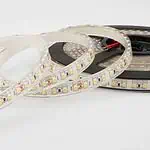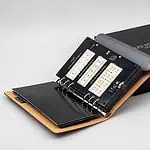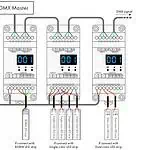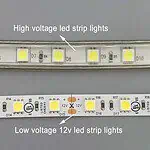What if you find the LED strip too thick for the installation space? This will obviously mess up your lighting plan, as you won’t be able to fit the fixture into the narrow space. So, to avoid such situations, LED strip widths are a crucial consideration.
LED strips are available in a wide range of sizes/widths. The single-row LED strips usually have widths ranging from 1mm to 15mm. In contrast, the multiple-row LED strips can be as wide as 120mm. Considering the width of the LED strip is essential to ensure proper heat dispersion, flexible installation, etc. Besides, the size of the LED chip or SMD is an important factor for LED strip width.
Here, I have brought you a complete guide on the available LED strip width for different types of LED strips, their power consumption, and more. So, without any further delay, let’s jump into the discussion-
What Do You Mean By LED Strip Width?
LED strip width or LED tape width refers to the physical width or thickness of the LED strip lights. In these flexible light fixtures, LED chips are arranged on a printed circuit board or PCB, which gives it structure. So, LED strip width basically indicates the width of the PCB. It is usually measured in millimeters (mm) or inches (inch). The width size varies for different brands, yet the most common widths are- 8mm, 10mm, and 12mm. However, based on the width, LED strips can be of two types-
- Single-Row LED Strip: Single-row LED strips have only one row of LED chips running throughout the length of the LED strips. The width of these fixtures usually ranges from 1mm to 15mm.
- Multiple-Row LED Strip: Multiple-row LED strips have more than one row of LED chips running throughout the PCB. This makes them wider than single-row LED strips; they can be as wide as 120mm. These LED strips can be a double-row, triple-row, quad-row, five-row, or more. As the rows increase, the width of the strips also increases. However, this also depends on the size of the chip or SMD. For instance, a triple-row LED strip of SMD5050 has a width of 32mm or 58mm. In contrast, the width of a triple-row SMD3528 LED strip is 20mm.

Why Is It Important To Consider LED Strip Width?
The width of the LED strip is a crucial consideration because it has a direct impact on the heat dispersion process. Besides, there are some other reasons for which you should consider the LED strip width. These are as follows-
Heat Dispersion: LED strips generate heat while operating. Passing this generated heat in the LEDs to the PCB and thus to the surrounding environment is essential to keep the fixture cool. In this case, having a wider LED strip acts as a heatsink to absorb and distribute heat away from the LEDs. Compared to narrow PCBs, wider ones work more effectively. To learn more about this topic, check out LED Heat Sink: What Is It and Why It’s Important?
Size of LED Chip: The size of the LED chip must fit the PCB of the LED strips. SMD numbers determine the chip size. For instance, an LED strip of SMD 5050 means the chips have a width of 5.0mm and a length of 5.0mm. So, to fit a 5mm wide LED chip, the width of the PCB or LED strip must be greater than 5mm. If your strip width is smaller than the size of the LED chip, it obviously doesn’t make any sense. Usually, SMD 5050 LED strips have a width of 10mm or higher. However, it’s a concern of the manufacturers to take care of the compatibility of the LED chip with the strip wide. Nevertheless, you should have some basic idea of different LED chip sizes as they impact the light output. The point to remember is that bigger LED chips need wider PCBs. Check this for details- Numbers and LEDs: What Does 2835, 3528, and 5050 Mean?
Density of LEDs and Circuit Layout: Wider PCBs allow for a denser arrangement of LEDs and circuits. This is particularly important for RGB and RGBW LED strips, which require multiple channels (4 or 5) to operate correctly. A wider PCB can accommodate these additional circuits, ensuring proper functioning and enhancing the overall light output and color mixing capabilities. For more on the principles of RGB LED strips, read What is RGB Lighting?
Installation Space: If your installation space is very narrow, fitting a wider LED strip can be difficult. So, it is essential to check the width of the LED strip to ensure it fits in the space where you want to install it. Besides, for corners or edges, narrow strips are more suitable as you can easily bend them.
Visual & Light Output: Wide LED strips are more visible, especially when lights are turned off and you have not hidden them. This can be visually unpleasant. In this case, you can go for the narrow LED steps that are not very visible.
Using Aluminum Channels: When you are adding aluminum channels or silicone diffusers to your light strip, the width of the fixture is a crucial consideration. Adding aluminum channels provides a soft and even light output, but if the strip width is not perfect, you will face issues while setting it up. In this case, you need to consider the inner width of the channel to the PCB of your LED strip. For instance, you can’t pass a 10mm LED strip to a 5mm aluminum channel or silicon diffuser. For more information about LED aluminum profiles, read Ultimate Guide To Aluminum Profile For LED Strip.

How Wide Are LED Strip Lights
The width of LED strips varies by brand and also depends on the type of LED strip and the size of the LED chip. The common widths for LED strips are 8mm, 10mm, and 12mm. Below are the most common widths available for different categories of LED strips and their corresponding chip sizes (SMD):
1. Single Color LED Strip Width
Single-color LED strips are also known as monochromatic LED strips. These are the most common and basic variants of LED strips. You will find them in a wide range of sizes based on the SMDs. Here are the most common sizes available for single-color LED strips-
| Single Color LED Strips | |
| SMD | Width |
| SMD2835 | 8mm, 10mm, 12mm, 15mm |
| SMD1808 | 2mm, 3mm, 4mm, 8mm, 10mm |
| SMD5050 | 8mm, 10mm, 12mm, 15mm |
| SMD3528 | 5mm, 8mm, 10mm, 15mm |
| SMD3014 | 5mm, 8mm, 10mm |
| SMD2216 | 8mm, 10mm |
| SMD2110 | 5mm, 8mm, 10mm, 12mm |
| SMD5630 | 10mm, 15mm |
2. Tunable White LED Strip Width
If you are looking for color temperature adjustable LED strips, tunable white LED strips are surely your best choice to go for. These strips usually have a 10mm width that offers better heat dispersion. Yet you will find 5mm strips with small LED chip sizes if you want a thinner option. Here are the available wide of tunable white LED strips-
For more information about tunable white LED strips, please read the articles:
| Tunable White LED Strips | |
| SMD | Width |
| SMD3528 | 10mm |
| SMD2835 | 8mm, 10mm |
| SMD5630 | 10mm |
| SMD3014 | 10mm |
| SMD5050 | 10mm |
| SMD3527 | 10mm |
| SMD1808 | 5mm, 10mm |
| SMD2010 | 5mm. 10mm |
| COB Tunable White | Three wire 10mm Two wire 8mm |
3. Dim-To-Warm LED Strip Width
Dim-to-warm lights give you warm color temperature adjustability. These lights are excellent for residential spaces to create a warm and cozy ambiance. The most common width of dim-to-warm LED strips are as follows-
For more information on the principles behind dim-to-warm technology, please read the article “Dim To Warm – What It Is and How Does It Work?“
| Dim-To-Warm LED Strips | |
| SMD | Width |
| SMD2216 | 10mm |
| SMD2835 | 10mm |
| COB Dim-To-Warm | 12mm |
RGB stands for red, green, and blue. RGB LED strips can create up to 16 million hues by combining these three primary colors. These chips usually come in wider PCBs, as SMD5050 is mostly used for RGB strip lighting. This is because SMD5050 has three diodes in one housing, which makes them ideal for RGB. However, due to the large LED chip size, the LED density is not much in these chips. If you need a more dense solution, SMD3838 is an ideal fit; it can be as narrow as 5mm.
| RGB LED Strips | |
| SMD | Width |
| SMD5050 | 10mm, 12mm, 20mm |
| SMD3838 | 5mm, 8mm, 10mm, 12mm |
| SMD2835 | 5mm, 8mm, 10mm, 12mm |
RGBW stands for red, green, blue, and white. RGBW LED strips are special because they have an extra white chip along with the regular red, green, and blue ones. This extra white chip helps create a wide range of colors and a clearer white light. These LED strips usually have a broader base and use a type of LED called SMD5050. These LEDs are great for RGBW strips because they can fit all four color diodes into one package. However, because these LED chips are bigger, there are fewer LEDs per foot on the strip.
We have two kinds of RGBW LED strips: one with all four colors in one LED (RGBW 4-in-1), and another type where the white and the RGB LEDs are separate (RGB+W). This gives you more options to choose the right lighting for your needs.
| RGBW LED Strips | |
| SMD | Width |
| SMD5050 (RGBW 4 chips in 1 LED) | 10mm, 12mm |
| SMD3838(RGB) + SMD2010(W) | 10mm |
6. RGBTW(RGB+Tunable White) LED Strip Width
RGBTW stands for Red, Green, Blue, Tunable White. RGBTW LED strips are advanced due to an additional tunable white chip that allows for adjusting the white light’s color temperature. This flexibility enables the creation of a vast spectrum of colors and more precise control over the white light settings. These strips typically utilize larger SMD5050 LEDs, which accommodate all five diodes in one unit, making them versatile for various lighting needs. However, the size of these LEDs means there are fewer per foot along the strip.
We offer two types of RGBTW LED strips. The first features a 5-in-1 LED, integrating RGBTW into a single chip, enhancing color blending and consistency. The second type, RGB+White White + White, has separate chips for RGB and two shades of white, providing more control over the intensity and temperature of the white light. This variety ensures you can select the ideal lighting for any environment.
| RGBW LED Strips | |
| SMD | Width |
| SMD5050 (RGBW 5 chips in 1 LED) | 12mm |
| SMD5050(RGB) + SMD2835(Warm White) + SMD2835(White) | 12mm |
What Is The Thinnest LED Light Strip?
The thinnest LED light strip available is the single color LED strip, which has a minimal thickness of just 2mm. Below is a table that outlines the thickness of various types of LED strips for easy comparison:
| Single Color LED Strip | 2 |
| Tunable White LED Strip | 4 |
| RGB LED Strip | 5 |
| RGBW LED Strip | 10 |
| RGBTW (RGB + Tunable White) LED Strip | 12 |
If you need very slim LED strips, check out our Ultra Narrow LED Strip series. These strips are perfect for places where you want lighting that is barely noticeable but still bright. For more details and to view our products, visit our Ultra Narrow LED Strip Series.
Are All LED Strip Lights The Same Width?
No, LED strip lights come in different widths. Some are very thin for small spaces, while others are wider for more light and color choices.
LED Strip Widths For Most Popular SMDs & Their Properties
If you get deep into the internal scheme of LED strips, you will find numerous LED chips arranged throughout the PCB of the LED strip. These chips are the crucial component that emits light. The LED chips come in different sizes, and SMD numbers indicate it. For larger chip sizes, the width of the LED strip also increases. So, if you need very narrow LED strips, go for smaller chip sizes or SMDs. Below, I will discuss the available LED strip width for the most popular LED strips- 5050, 3528, and 2835:
How Wide Are 5050 LED Strip Lights?
A 5050 LED strip light contains LED chips 5mm wide and 5 mm long. These chip sizes are popular for RGB LED strips. However, you can also find them on single-color LED strips or others. As the chips used in these LED strips are wider, the PCBs used in these fixtures are also wide. So, 5050 LED strips come in thick sizes. Regarding power consumption, these strips use more energy than the ones with smaller chips. It takes 0.24 watts to run a 5050 LED strip of density 60 LED per meter. As an example, a meter 5050 LED strip consumes 14.4 watts. The power consumption and width also vary based on the number of rows each strip has. The common width of 5050 LED strips are as follows-
| Variants of 5050 LED Strips | Width |
| Single Row 5050 LED Strip | 10mm, 12mm, 15mm |
| Double Row 5050 LED Strip | 15mm |
| Triple Row 5050 LED Strip | 32mm or 58mm wide |
| Five Rows 5050 LED Strip | 58mm wide |
| Eight Rows 5050 LED Strip | 120mm |
How Wide Are 3528 LED Strip Lights?
3528 LED strips refer to the strip lights that are 3.5mm wide and 2.8mm long. These chips are circular in shape and use less energy than 5050 LED strips. This makes them more energy-efficient. However, 3528 LED strip lights are popular for monochromatic or single-color LED strips. Besides these chips are also used in RGB LED strips. The available width of 3528 LED strip light includes-
| Variants of 3528 LED Strips | Width |
| Smallest 3528 LED Strip | 3.5 mm |
| Single Row 3528 LED Strips | 8mm or 10mm |
| Double Row 3528 LED Strip | 15 mm |
| Triple Row 3528 LED Strips | 20mm |
| Quad Row 3528 LED Strips | 28mm |
How Wide Are 2835 LED Strip Lights?
2835 LED strips are rectangular-shaped LED chips with 2.8mm width and 3.5mm length. As these chips are small in size, 2835 LED strips can be narrow in shape. The thinnest 2835 LED strips are 3.5mm wide. These are widely used for medical and thermal applications. However, these LED strips are less heat dispersion friendly compared to 3528 and 5050 LED strips. To avoid overheating issues, add aluminum profile accessories to enhance LED heat dissipation. The available width for 2835 LED strips is as follows-
| Variants of 2835 LED Strips | Width |
| Thinnest 2835 LED Strip | 3.5mm |
| Single Row 2835 LED Strip | 5mm, 6mm, 8mm, 10mm |
| Double Row 2835 LED Strip | 15mm, 20mm |
| Triple Row 2835 LED Strip | 16mm, 22mm, 32mm |
| Quad Row 2835 LED Strip | 28mm, 30mm |
| Five Rows 2835 LED Strip | 64mm |

Do Wider LED Strips Consume More Energy?
A wider LED strip doesn’t necessarily mean it will consume more energy. It depends on the LED density, size of the chip, its quality, and power supply. However, bigger LED chips consume more energy. For instance, a 5050 LED strip of 10mm consumes more energy than a 2835 LED strip of the same width. Again, if the density of two 2835 LED strips has the same density and power supply, but one is 5mm and the other 10mm, it doesn’t mean the wider one will use more energy. In this case, the width of the LED strip is not directly related to power consumption.
Yet, as I said before, the power consumption of the LED strip with a bigger chip is more than that of a small chip. But the difference is minimal. For instance, a 2835 and a 5050 LED strip with a density of 60 LED/meter, the energy consumption is as follows-
| LED Chip Type | Power Draw Per Chip | Power Draw Per Meter (60 LED Strip) |
| 2835 | 0.2 Watts | 12 Watts |
| 5050 | 0.24 Watts | 14.4 Watts |
The average LED strip’s difference per meter is just over 2 Watts. Though it will affect the power draw, it won’t really show up in long-term cost calculations.
Besides, the density of the LED strip is a major consideration regarding power consumption. The LED strip is highly dense; it has more LED chips to power. As a result, it consumes more energy. That is, an LED strip of 10mm width with 60LED/meter will consume more energy than a 10mm width LED strip of 30 LED/meter.

Application Of LED Strip: Narrow Vs. Wide Width Strips
Depending on the thickness or width, LED strips can be narrow or wide. The narrow LED strips are excellent for accent lighting, whereas wide-width LED strips are best for general lighting. They have versatile applications; these are as follows-
Narrow Width LED Strips
Narrow-width LED strips are the thinner strips that have a slim and compact size. They can be 1mm to 6mm in width. The slim structure of these LED strips works excellent for tight spaces and corner installation. You can use them to enhance the visuals of your interior creatively. The major plus point of using these LED strips is that they are highly energy efficient. But the drawback here is that due to minimal width, the heat is not easily dispersed away from the chip as there’s not much space in the PCB. That is why you should attach the narrow strips to the heat sink, like an aluminum profile or some other heat-dissipating material, to ensure the strips don’t get overheated.
| Pros | Cons |
| Ideal for subtle lighting applications Well-suited for accent lighting Highly energy efficient Ideal for DIY projects | Less visibility Overheating issues May not be as bright as wider strips |
Application
- Display cases
- Shelving and bookcases
- Artwork or museum lighting
- Under cabinet lighting
- Cove lighting
- Stair lighting
- Under kickboards
- Inside cabinets
- TV backlighting
- Mirror backlighting
- Under counter lighting
- Tight spaces like beneath the car seats, corners, etc.
Wide Width LED Strips
Wide LED strips are the ones with thick or wide PCBs. They can be 8mm, 10mm, 12mm, or as wide as 120mm! The single-row LED strips are not very wide, but there are multiple-row LED strips available that can be very wide. The advantage of using wide LED strips is that they have a good heat dispersion system. The heat produced with the LED chip is evenly distributed throughout the PCB and thus keeps the fixture cool. So, with these LED strips, you won’t face overheating issues that can keep your strip running longer.
| Pros | Cons |
| Better heat dispersion Bright lightConsistent and uniform lighting Extensive coverage | Consume more energy than narrow-width LED strips. |

Application
- General lighting
- Architectural highlights
- Large display or signage
- Automotive and marine lighting
- Retail and commercial spaces
- Industrial and warehouse lighting
- Office spaces
- Hospitality sectors like- restaurants, hotels, etc.
- Outdoor lighting
LED Strips 10mm VS 12mm Width
When selecting between 10mm and 12mm LED strips, your choice will largely depend on the specific needs of your installation. Below is a comparison highlighting key aspects to help you decide which width is better suited for your requirements:
| Width | 10mm, narrower for easier installation | 12mm, allows for higher power and denser LEDs |
| Ease of Installation | More convenient, fits more aluminum profiles | Requires specific profiles for optimal fitting |
| Power Handling | Standard power suitable for general use | Higher potential power for increased brightness |
| LED Density | Standard density | Higher density, results in more uniform lighting |
FAQs
Ultra-narrow LED strip of 1mm width is the thinnest LED strip in the market. You can use them in any tight or narrow spaces. The slim-fit size and flexibility allow you to install these thin LED strips to corners by bending them to the desired shape. You can further use them for highlighting artwork or other creative projects.
The width of the LED strip depends on the type of strip and SMDs. They can be as narrow as 2mm for small-size LED chips. Again, LED strips can be as wide as 28mm or even 120mm. In this type of strip, multiple rows of LEDs are arranged to give a wider structure; this is why they are also known as multi-row LED strips.
No, all LED strip lights don’t have the same width. Based on the type of LED, size of chip, LED density, etc., there are a variety of widths available for LED strips. They can be as thin as 1mm or as wide as 12mm. The multiple-row LED strips can be as wide as 120mm.
Of course, the width of the LED strip matters. It isn’t just about LED visuals or the appearance of the fixture; the width of the LED strip has more to deal with. For instance, a wider LED strip has a better heat dispersion facility. In contrast, you need to use a heat sink or aluminum profile for narrow LED strips as they are not good at heat dispersion. Again, when you use a diffuser with LED strips, its inner width must match the width of the LED strips to fit in. Besides, the size of the LED chip is also related to the LED strip width; bigger chips require a wider PCB, and they consume more energy. In this way, energy consumption is also indirectly related to LED strip width.
No, the SMD and width of the LED strips are not the same. SMD stands for ‘Surface Mounted Diode.’ It indicates the size of the chip used in the LED strip. For example, an SMD2835 LED strip means that the LED chip within the strips has a size of 2.8mm x 3.5mm. In contrast, the width of the LED strip refers to the width of the PCB in which the LED chips are arranged. Now, the relation between SMD and the width of the LED strip is that, for a greater SMD number, a wider LED strip is required. For example, an SMD5050 LED strip has a width of 5mm; you can’t fit it to an LED strip that has a PCB of 2mm width.
The standard LED strip width varies for different applications. For tight spaces or aesthetic visuals, you may need narrow strips of 2mm or 3mm. Again, for large installations, you might look for wider or multiple-row LED strips that can be 120mm thick.
LED strips come in different sizes. Length-wise, it usually comes as 5 meters per reel, but it can be as long as 60 meters per reel or above. However, considering the width, LED strips usually have a width of 2mm-12mm. But still, they can be as narrow as 1mm or wider as 120mm.
5050 LED strips are usually wider than the 2835 LED strips as they are composed of bigger chips. The width of 5050 LED strips is 10mm, 12mm, and 15mm. However, the multiple-row 5050 LED strips can be up to 120mm (eight-row) width. In contrast, 2835 LED strips are available in a width ranging from 3.5mm to 64mm.
The Bottom Line
The width of the LED is essential to ensure your fixture fits the installation space properly. If you have a very tight and congested space to mount LED strips, try our Ultra Narrow LED Strip. They have a width ranging from 2mm-5mm and are highly energy efficient. However, when using these fixtures, you must attract a heat sink or aluminum profile to ensure proper heat dispersion. But with wide LED strips, you won’t need to worry much about this factor.
Whatever LED strip width you are looking for in your lighting project, LEDYi is your ultimate solution. We have a wide range of LED strips that will meet your requirements. Besides, we also offer customization, ODM, and OEM facilities. So, contact us ASAP to get your desired LED strip width!














